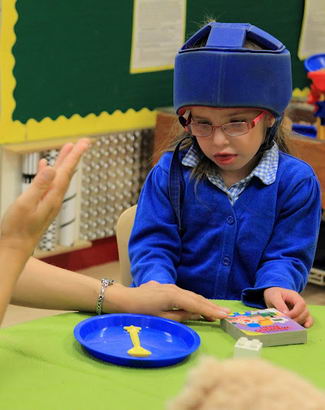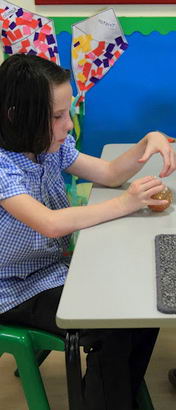...perception, memory, forming ideas, language and use of symbols...underlie the ability to...solve problems.
Qualifications and Curriculum Authority, 2009
Educators of children with SLD/PMLD/CLDD can enhance problem-solving thought processes through daily classroom activities.
Early thinking skills include:
- Using intuition.
- Predicting and anticipating.
- Remembering.
- The understanding of cause and effect.
- Linking objects, events and experiences.
- Thinking creatively.
- Thinking about thought processes.
(QCA, 2009; Wallace et al, 2004)

The following slides focus on a cognition issue with children with SLD/PMLD/CLDD. Background information about the cognition developmental area can be found at Level B.
Children with SLD/PMLD/CLDD will need adult guidance, assistance and scaffolding for these Thinking Actively in a Social Context (TASC) processes:
- Gathering/organising: use memory to link different pieces of information.
- Identifying: make the task and criteria for successful completion clear.
- Generating ideas: encourage learners to think and consider several ideas.
- Deciding: reason why one idea is better.
- Implementing.
- Evaluating: every task can be improved.
- Communicating: the thrill of communicating and sharing outcomes.
- Learning from experience: consolidating and generalizing learning.
(See: Wallace et al, 2004)

Children with SLD have fewer neurons and synapses and
thus struggle with all areas of thinking, for example sensory integration and perceiving sensory patterns; singling out relevant
features of stimuli and attending to them; generalising learning; and associating words with concepts...
We also know that although damaged neurons [in the brain] do not recover, other neurons can take over and restore at least
some of the function of those destroyed... This seems to be fairly convincing evidence that ...stimulating the brain can result
in an improvement in thinking.
Lacey, 2009

Children with SLD/PMLD/CLDD will have difficulties with:
- Processing information they see and hear;
- Using strategies for remembering things;
- Retaining information and building up general knowledge;
- Thinking about and understanding the world around them;
- Problem solving and using skills in new situations;
- Understanding and using language;
- Making connections between ideas.
(Lacey and Bradley, 2008)
Children with SLD are not natural problem-solvers because they may have difficulty in:
- Recognising problems;
- Identifying or attending to the key aspects
of a problem; - Predicting, planning and carrying out a solution.
(Lacey, 2009)
Educators can support children with SLD to develop thinking skills by, for example:
- Creating opportunities to remember;
- Creating opportunities for the child to notice a difference (eg between two simple tableau; making a change in a familiar space);
- Creating supported problem-solving solutions, (eg initially a choice from two offered solutions);
- Using simple 'thinking skills' words such as memory, remember, thinking, problem-solving, difference.
(Lacey and Bradley, 2008)

Through an integration of sensory perceptions and physical movements and through the frequent repetition
of actions that bring about certain effects, sensory-motor action schemes are developed. They are the foundation of single
problem solving behavior.
Petry et al, 2007
The following domains of knowledge (after Piaget) are considered important for children with PMLD:
- Object permanence.
- Imitation (verbal and gestural).
- Cause and effect.
- Object relations in space.
- Sensori-motor schemes.
(Petry et al, 2007)

Teaching pre-verbal young adults with severe and complex learning difficulties and profound intellectual impairment focuses the mind on fundamental questions of what is meaningful learning and how we can facilitate it. The fundamental principles are:
- The learner is active... 'a fully active participant in the activities, intellectually and emotionally engaged with the content and the teacher, making decisions, exploring and experimenting, exercising personal power'.
- The learning activity is intrinsically rewarding and motivating.
- The learner shares control of the activity with the teacher.
Using the TASC principles from page 2 as a guide, plan how you will facilitate and scaffold these for a learner with SLD/PMLD/CLDD whom you work with.

Clavio, J.C.V. and Fajardo, A.C. (2008) Toys as instructional tools in developing problem-solving skills in children, Education Quarterly, 66 (1), 87-100.
Lacey, P. (2011) A profound challenge, SEN Magazine, (1.12.11).
Lockhart, S. (2011) Active learning for infants and toddlers, ReSource, (Spring), 5-10.
Northern Ireland Curriculum (2009) To Be Me: A personal development and mutual understanding thematic unit. Belfast: Council for the Curriculum Examinations and Assessment.

Simmonds, B. (2011) The 'PMLD ambiguity': articulating the lifeworlds of children with profound and multiple learning difficulties. Paper presented at the Nordic Network on Disability Research (NNDR) 11th Annual Conference, Reykjavik, Iceland (28.05.2011).
Welsh Government (2006) Routes for Learning. Cardiff: Welsh Government.
For additional reading and references click here.